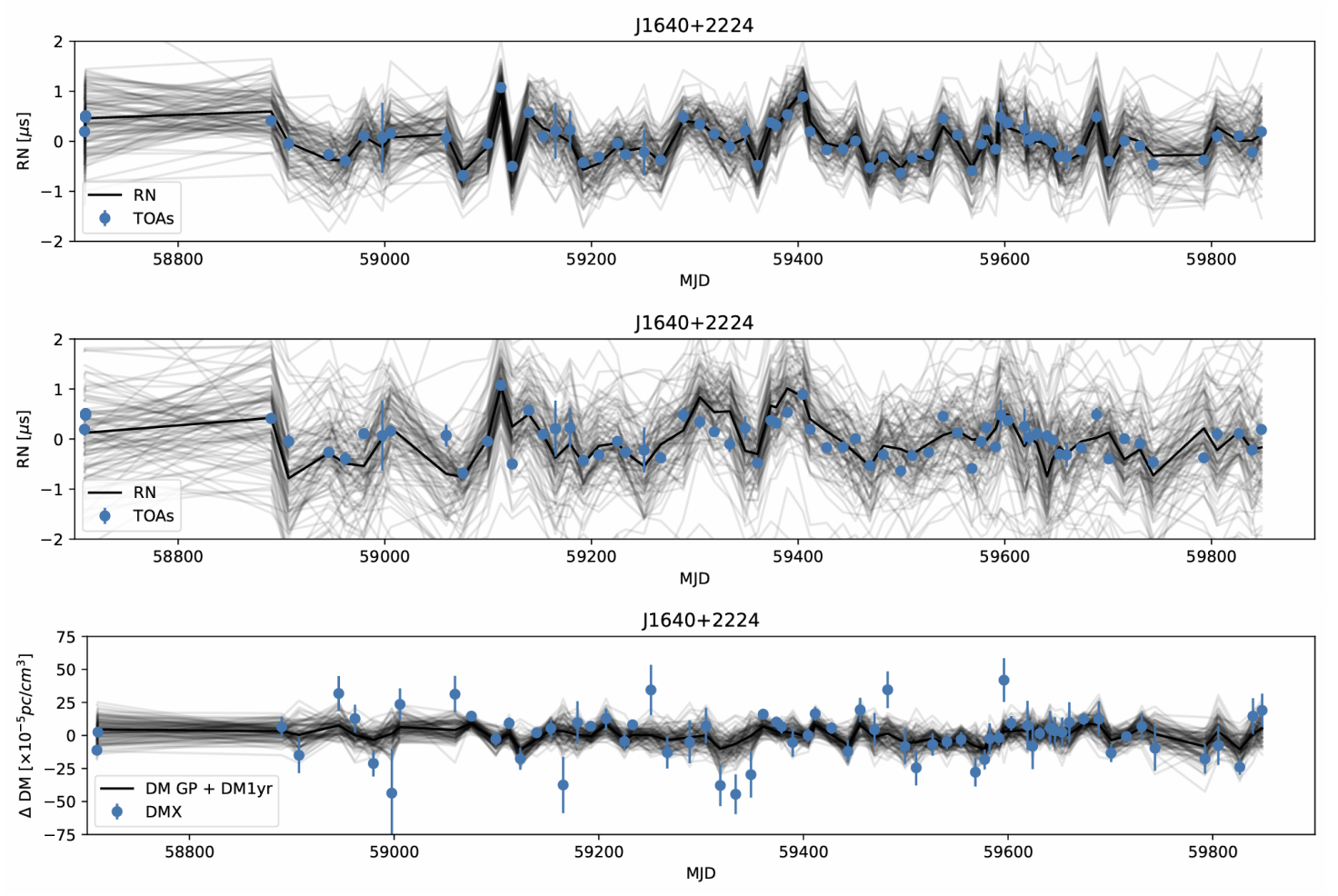Shanghai Astronomical Observatory Researchers Make New Progress in Pulsar Timing Array Data Analysis—Advancing Nanohertz Gravitational Wave Detection
Recently, the research team from the Shanghai Astronomical Observatory (SHAO) of the Chinese Academy of Sciences has achieved two significant advances in the field of Pulsar Timing Array (PTA) research, providing more reliable support for the detection of nanohertz gravitational waves. The related findings have been published in the astronomical journals《Monthly Notices of the Royal Astronomical Society》and《Astronomy & Astrophysics》.
The detection of nanohertz gravitational waves is a global scientific endeavor that has been underway for over a decade. The primary principle involves monitoring a set of ultra-high-precision pulsars to form a galaxy-scale detector network—the Pulsar Timing Array (PTA). Several researchers from SHAO are deeply involved in multiple international PTA collaborations, including the European Pulsar Timing Array (EPTA), the Chinese Pulsar Timing Array (CPTA), and the International Pulsar Timing Array (IPTA), a consortium of regional PTA collaborations worldwide.
Scientists treat pulsars as precise cosmic clocks, detecting gravitational waves by monitoring the arrival times of their signals on Earth. Much like encountering static noise in a radio broadcast, they must first calibrate the timing measurements (timing models) of these cosmic clocks and filter out various cosmic interferences (noise models) to ensure the detected gravitational wave signals are genuine and reliable.

Figure 1: Schematic diagram on detecting gravitational waves with Pulsar Timing Arrays (Credit: IPTA)
Systematic bias caused by solar wind in pulsar timing
A research team led by Dr. Kuo Liu from SHAO has systematically revealed the correlation between the solar wind and the astrometric parameters of millisecond pulsars. The study found significant correlations between pulsar positions, annual parallax measurements, and solar wind parameters, with the correlations varying depending on the pulsar’s ecliptic latitude. This effect may introduce systematic biases in the astrometric parameters of the timing models. The team further validated this phenomenon using the second data release from the European Pulsar Timing Array (EPTA DR2). By adjusting solar wind parameters, the parallax and position measurements of pulsars became more consistent with data from other PTAs and different observational techniques. The study also demonstrated that incorporating astrometric distance measurements of pulsars and low-radio-frequency timing data can enhance the overall accuracy of pulsar timing.

Figure 2: Correlation coefficients between the solar wind intensity and annual parallax parameters in the timing model for pulsars at three different ecliptic latitudes, under varying timing precision and observational frequency ranges. The results show distinct correlations under different conditions, with near-perfect correlation observed at high ecliptic latitudes and limited frequency coverage.
Constructing noise models for the Chinese Pulsar Timing Array
A research team led by Dr. Siyuan Chen from SHAO has developed pulsar noise models using the first data release from the Chinese Pulsar Timing Array (CPTA DR1). Despite the CPTA’s observation time span of only about three years, the ultra-high sensitivity of the FAST radio telescope enabled the team to analyze various noise components in the data. To ensure model reliability, the team employed four independent analysis pipelines for cross-validation and established a robust noise model for each pulsar based on Bayesian methods. Among the 57 millisecond pulsars in CPTA DR1, noise characteristics for about 50 have been precisely constrained, while the remaining pulsars showed no signs of long-term noise. These models have been applied to the gravitational wave searches based on the CPTA DR1, yielding results that are highly consistent with those from other PTA collaborations and demonstrating significant scientific value from the CPTA DR1.

Figure 3: Noise analysis results for the millisecond pulsar J1640+2224 in the CPTA DR1 dataset. The solid lines represent reconstructed frequency independent red noise (top two rows) and variations in dispersion measure (bottom row) in the time domain. Blue dots mark the observational values with uncertainties obtained using data from the FAST radio telescope.
These two studies lay an important foundation for future work, including the third data release of the International Pulsar Timing Array (IPTA DR3). They will continue to drive advancements in high-precision pulsar timing, pulsar noise modeling, and nanohertz gravitational wave signal analysis.
Paper Links:
[1] https://academic.oup.com/mnras/article/536/3/2603/7921602
[2] https://www.aanda.org/articles/aa/full_html/2025/07/aa52550-24/aa52550-24.html
Scientific Contacts:
[1] Kuo Liu, liukuo@shao.ac.cn
[2] Siyuan Chen, siyuan.chen@shao.ac.cn
Download attachments: